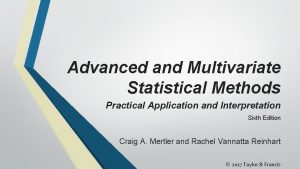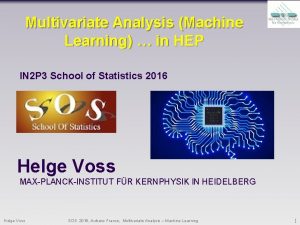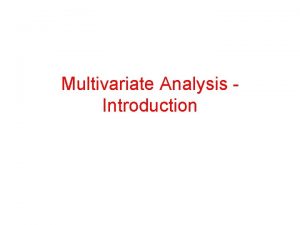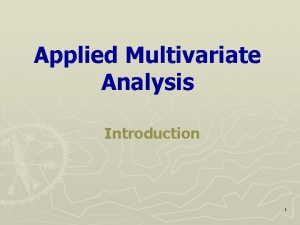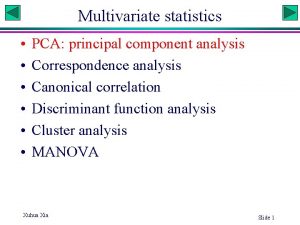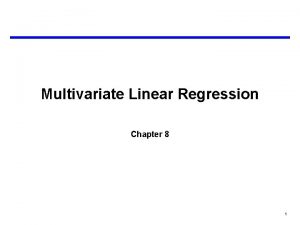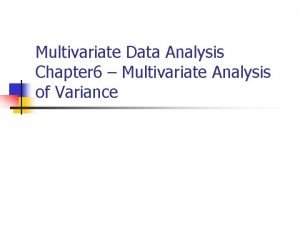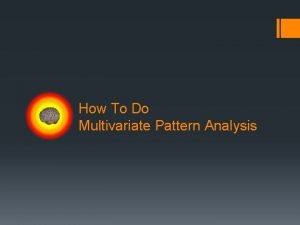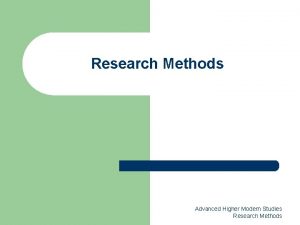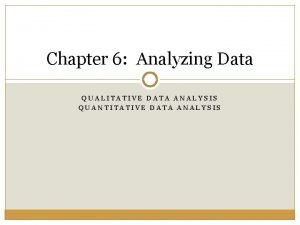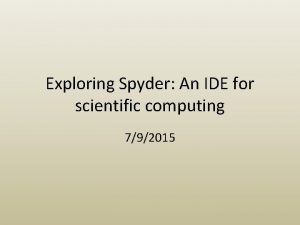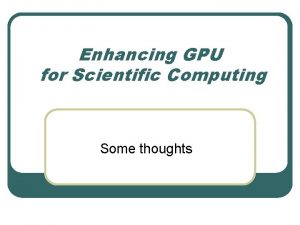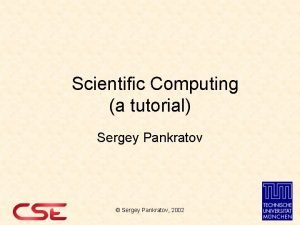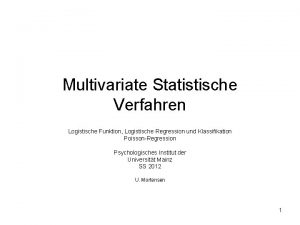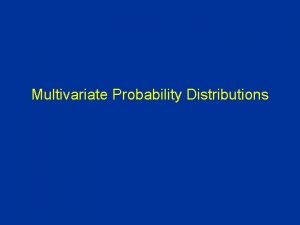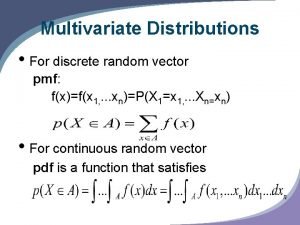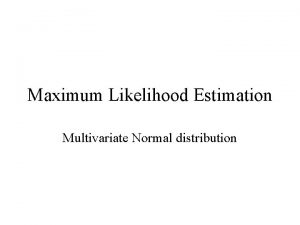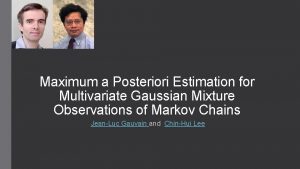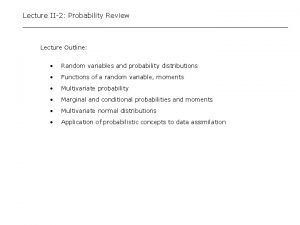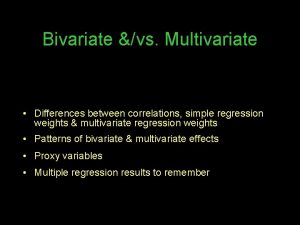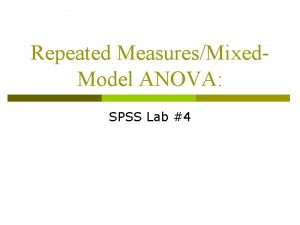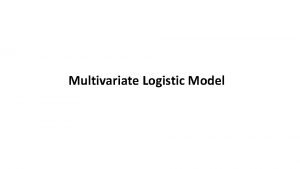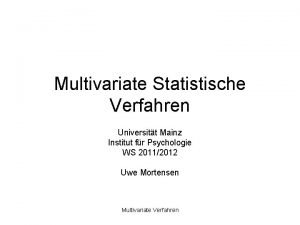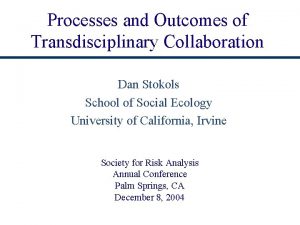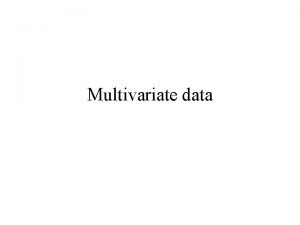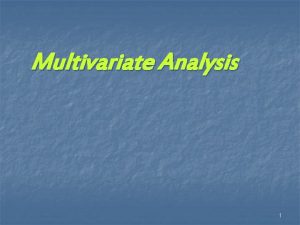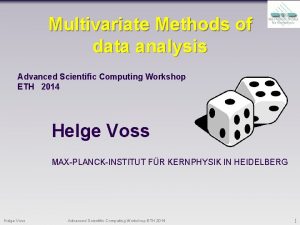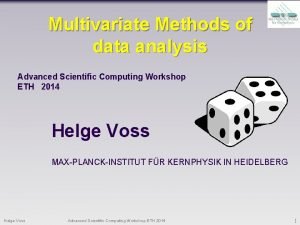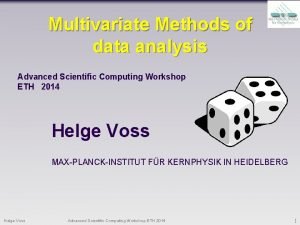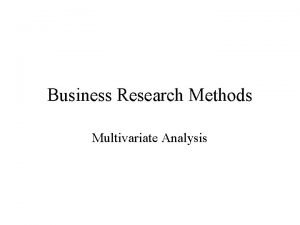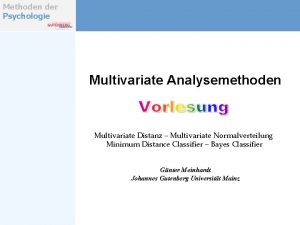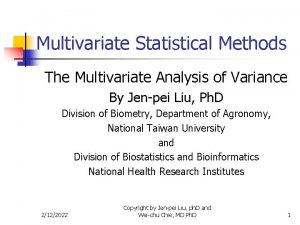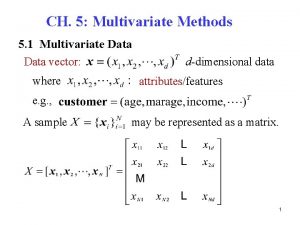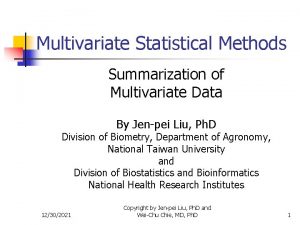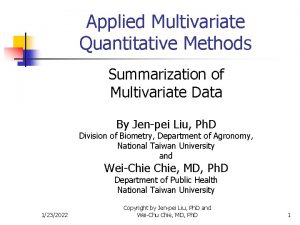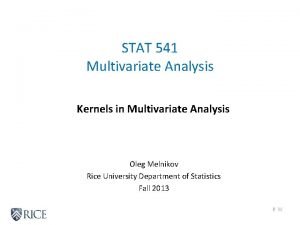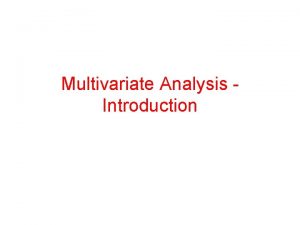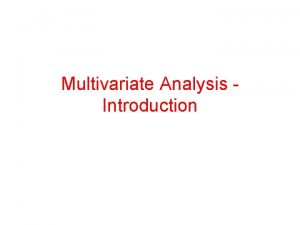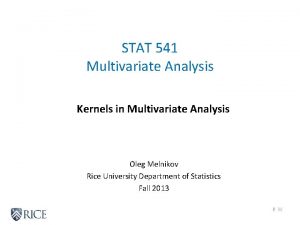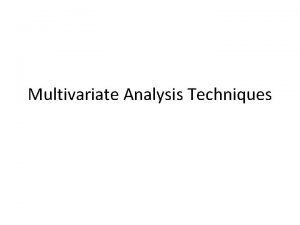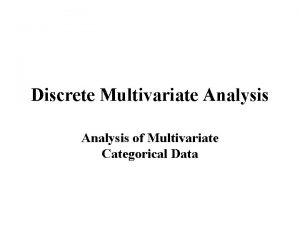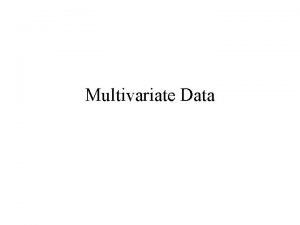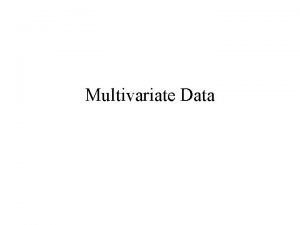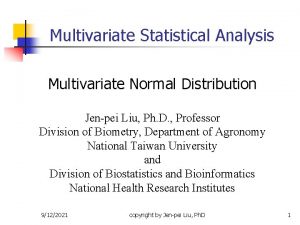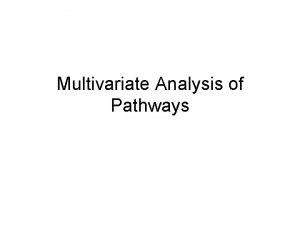Multivariate Methods of data analysis Advanced Scientific Computing


































- Slides: 34

Multivariate Methods of data analysis Advanced Scientific Computing Workshop ETH 2014 Helge Voss MAX-PLANCK-INSTITUT FÜR KERNPHYSIK IN HEIDELBERG Helge Voss Advanced Scientific Computing Workshop ETH 2014 1

Overview § Multivariate classification/regression algorithms (MVA) § what they are § how they work § Overview over some classifiers § Multidimensional Likelihood (k. NN : k-Nearest Neighbour) § Projective Likelihood (naïve Bayes) § Linear Classifier § Non linear Classifiers § Neural Networks § Boosted Decision Trees § Support Vector Machines § General comments about: § Overtraining Helge Voss § Systematic errors Advanced Scientific Computing Workshop ETH 2014 2

See some Classifiers at Work 1. 5 0. 45 y(x) Helge Voss Advanced Scientific Computing Workshop ETH 2014 3

Decision Boundaries BDT k. NN MLP LD Likelihood Helge Voss Advanced Scientific Computing Workshop ETH 2014 4

General Advice for (MVA) Analyses § There is no magic in MVA-Methods: no need to be too afraid of “black boxes” they are not sooo hard to understand you typically still need to make careful tuning and do some “hard work” no “artificial intelligence” … just “fitting decision boundaries” in a given model § The most important thing at the start is finding good observables good separation power between S and B little correlations amongst each other no correlation with the parameters you try to measure in your signal sample! § Think also about possible combination of variables this may allow you to eliminate correlations § rem. : you are MUCH more intelligent than what the algorithm § § Apply pure preselection cuts and let the MVA only do the difficult part. “Sharp features should be avoided” numerical problems, loss of information when binning is applied simple variable transformations (i. e. log(variable) ) can often smooth out these areas and allow signal and background differences to appear in a clearer way § Treat regions in the detector that have different features “independent” can introduce correlations where otherwise the variables would be uncorrelated! Helge Voss Advanced Scientific Computing Workshop ETH 2014 5

T MVA Categories § § TMVA Categories: one classifier per ‘region’ ‘regions’ in the detector (data) with different features treated independent Helge Voss |eta| > 1. 3 |eta| < 1. 3 Example: var 4 depends on some variable “eta” improves performance avoids additional correlations where otherwise the variables would be uncorrelated! Recover optimal performance after splitting into categories Advanced Scientific Computing Workshop ETH 2014 6

§ Overtraining how to choose ‘meta’ parameters “α” that determine the classifier ‘flexibility’ e. g. Number of Nodes in Neural network, number of training cycles, “size of neighbourhood (k)” in nearest Neighbour algorithms etc… § it seems intuitive that this boundary will give better results in another statistically independent data set than that one x 2 possible overtraining is concern for every “tunable parameter” a of classifiers: Smoothing parameter, n -nodes… S B x 1 x 2 S classificaion error verify on independent “test” sample Classifier is too flexible overtraining B Helge Voss True eff (estimated from test sample) training sample training cycles a Bias if ‘efficiency/performance’ is estimated from the training sample Advanced x Scientific Computing Workshop ETH 2014 7

Cross Validation § classifiers have tuning parameters “a” choose and control performance § #training cycles, #nodes, #layers, regularisation parameter (neural net) § smoothing parameter h (kernel density estimator) §…. § more training data better training results § division of data set into “training” and “test” and “validation” sample? Cross Validation: divide the data sample into say 5 sub-sets Test Train Test Train Train § train 5 classifiers: yi(x, a) : i=1, . . 5, § classifier yi(x, a) is trained without the i-th sub sample § calculate the test error: § choose tuning parameter a for which CV(a) is minimum and train the final classifier using all data Helge Voss Advanced Scientific Computing Workshop ETH 2014 8

Kolmogorov Smirnov Tests if two sample distributions are compatible with coming from the same parent distribution Statistical test: if they are indeed random samples of the same parent distribution, then the KS-test gives an uniformly distributed value between 0 and 1 !! Note: that means an average value of 0. 5 !! How does that look like for TMVA, where many people use the KS test to check for “overtraining” Helge Voss Advanced Scientific Computing Workshop ETH 2014 9

Kolmogorov Smirnov Test Default (ROOT) Setting option “X” (default in TMVA since 4. 2) Uses random sample generated from the two distributions that need to be compared Distributions are not really “flat” effect of using binned histograms (to be checked…) Helge Voss Advanced Scientific Computing Workshop ETH 2014 10

BDT performance vs #trees For background rejection of 99. 9% (bkg. Eff. 0. 1%) Notice: Best performance is at Max. Depth = 2 and Ntrees = 1000 That is NOT where the difference between true, test and training efficiency is minimal !!! Helge Voss Advanced Scientific Computing Workshop ETH 2014 11

BDT: Training Efficiency Testing Efficiency True Efficiency for nominal background eff 10% Helge Voss Advanced Scientific Computing Workshop ETH 2014 12

BDT: Training Efficiency Testing Efficiency True Efficiency for nominal background eff 0. 1% Helge Voss Advanced Scientific Computing Workshop ETH 2014 13

And for Cuts ? Bias is fairly small, but for 0. 1% bkg. Rejection still statistically significant: Training: eff. S = 6. 5% Testing : = 4. 2% True: = 4. 1 Difference: 2%+- 0. 06% Helge Voss Advanced Scientific Computing Workshop ETH 2014 14

Example distributions Background Rejection 99. 9% 0. 1% bkg events of 6000 bkg total in test and training sample = 6 events only train and test sample are highly “anti-correlated” But what is this? True eff. Vs test eff. Test eff. Is highly biased, too! Again: “artefact” of the small event count. Helge Voss True eff. BDT: Max. Depth = 2 Ntrees = 1000 Advanced Scientific Computing Workshop ETH 2014 Test eff. 15

Example distributions BDT: Max. Depth = 2 Ntrees = 1000 Background Rejection 99% The correlation between test and training efficiency is still there (1% bkg events of 6000 bkg total in test and training sample = 60 events !!) True eff. Bias between true and test eff. disappeares with larger event counts, despite train-test correlation still visible Helge Voss Advanced Scientific Computing Workshop ETH 2014 Test eff. 16

Example distributions BDT: Max. Depth = 2 Ntrees = 1000 Background Rejection 90% The correlation between test efficiency and training efficiency is almost gone, as the samples left and cut away are both big enough True eff. All correlations seem gone, we are only left with an ever smaller bias between true (test) and training eff. Helge Voss Advanced Scientific Computing Workshop ETH 2014 Test eff. 17

Systematic Errors/Uncertainties Helge Voss Advanced Scientific Computing Workshop ETH 2014 18

Some Words about Systematic Errors § Typical worries are: § What happens if the estimated “Probability Density” is wrong ? § Can the Classifier, i. e. the discrimination function y(x), introduce systematic uncertainties? § What happens if the training data do not match “reality” Any wrong PDF leads to imperfect discrimination function Imperfect (calling it “wrong” isn’t “right”) y(x) loss of discrimination power that’s all! classical cuts face exactly the same problem, however: in addition to cutting on features that are not correct, now you can also “exploit” correlations that are in fact not correct § Systematic error are only introduced once “Monte Carlo events” with imperfect modeling are used for § efficiency; purity §#expected events § § same problem with classical “cut” analysis § use control samples to test MVA-output distribution (y(x)) Combined variable (MVA-output, y(x)) might “hide” problems in ONE individual variable more than if looked at alone train classifier with few variables only and compare with data Helge Voss Advanced Scientific Computing Workshop ETH 2014 19

MVA and Systematic Uncertainties Helge Voss Advanced Scientific Computing Workshop ETH 2014 20

MVA and Systematic Uncertainties Don’t Helge Voss be afraid of correlations! typically “kinematically generated” easily modeled correctly “classical cuts” are also affected by “wrongly modeled correlations” MVA method let’s you spot mis-modeled correlations! “projections” of input variables + the combined MVA test statistic “y(x)” ! Advanced Scientific Computing Workshop ETH 2014 21

Systematic “Error” in Correlations • Use as training sample events that have correlatetions • optimize CUTs • train an propper MVA (e. g. Likelihood, BDT) • Assume in “real data” there are NO correlations SEE what happens!! Helge Voss Advanced Scientific Computing Workshop ETH 2014 22

Systematic “Error” in Correlations • Compare “Data” (Test. Sample) and Monte-Carlo (both taken from the same underlying distribution) Helge Voss Advanced Scientific Computing Workshop ETH 2014 23

Systematic “Error” in Correlations • Compare “Data” (Test. Sample) and Monte-Carlo (both taken from the same underlying distributions that differ by the correlation!!! ) Differences are ONLY visible in the MVA-output plots Helge Voss Advanced Scientific Computing Workshop ETH 2014 (and if you’d look at cut sequences…. ) 24

(T )MVA and Systematic Uncertainties q minimize “systematic” uncertainties (robustness) “classical cuts” : do not cut near steep edges, or in regions of large sys. uncertainty hard to translate to MVAs: artificially degrade discriminative power (shifting/smearing) of systematically “uncertain” observables IN THE TRAINING remove/smooth the ‘edges’ MVA does not try to exploit them First attempts to automatize this are on the way Signal Background § Note: if I KNEW about the error, I’d correct for it. I’m talking about ‘unknown’ systematics Helge Voss Advanced Scientific Computing Workshop ETH 2014 25

How does this look in 2 D? MVA-decision boundaries • Looser MVA-cut wider boundaries in BOTH variables What if you are sure about the peak’s position in var 1, but less sure about var 0 ? • You actually want a boundary like THIS • Tight boundaries in var 1 • Loose boundaries in var 0 Helge Voss Advanced Scientific Computing Workshop ETH 2014 26

Reduce information content § Looking for a general tool to ‘force’ any MVA algorithm, not to rely too much on exact feature: § Similar: early stopping techniques in Neural networks to avoid overtraining reduce difference between “signal” and “background” or reduce information content in each, “signal” and “background” § Here: one would for example “shift” such that signal and backgr. are less separated § However, that’s not “universal” Helge Voss Advanced Scientific Computing Workshop ETH 2014 27

Reduce information content § Looking for a general tool to ‘force’ any MVA algorithm, not to rely too much on exact feature: § Similar: early stopping techniques in Neural networks to avoid overtraining reduce difference between “signal” and “background” or reduce information content in each, “signal” and “background” shift smear turn Helge Voss Advanced Scientific Computing Workshop ETH 2014 28

Reminder: MVA-decision boundaries • Looser MVA-cut wider boundaries in BOTH variables • You actually want a boundary like THIS • Tight boundaries in var 1 • Loose boundaries in var 0 § YES it works ! Helge Voss Advanced Scientific Computing Workshop ETH 2014 29

Another example. . § Hmm… also here, I’d still say it does exactly what I want it to do § The difficulty is to ‘evaluate’ or ‘estimate’ the advantage (reduction in systematic loss in performance) Helge Voss Advanced Scientific Computing Workshop ETH 2014 30

peak on the edge AGAIN: assume uncertainty in position of peak in var 0 bad Helge Voss better Advanced Scientific Computing Workshop ETH 2014 but by how much? ? 31

Back to my “complicated” 3 D example Helge Voss Advanced Scientific Computing Workshop ETH 2014 32

ROC Cuve - Zoom § compare: difference between red (what you think you have) and black (what your algorithm applied to nature might actually provide) § do this for solid (smeared) and dashed (unsmeared) classifiers Helge Voss Advanced Scientific Computing Workshop ETH 2014 33

Summary § Multivariate Classifiers (Regressors) “MVAs” (fit) decision boundary (target function) § direct exploitation of Neyman-Pearson’s Lemma: (best test statistic is the Likelihood ratio ) direct pdf estimate in § multi-dimensional (and projective) Likelihood § classifiers that “fit” a decision boundary for given “model” § Linear: Linear Classifier (e. g. Fisher Discriminant) § Non-Linear: ANN, BDT, SVM § MVA should never be used as “black box” § they are just ‘functions’ of the observables and can be ‘studied’ even w/o knowing how the function is implemented MVA output distributions § compare different MVAs ! § find working point on ROC curve § MVAs are not magic … just fitting § systematic uncertainties don’t lie in the training !! § estimate them similar as you’d do in classical cuts Helge Voss Advanced Scientific Computing Workshop ETH 2014 34
 Advanced and multivariate statistical methods
Advanced and multivariate statistical methods Multivariate methods in machine learning
Multivariate methods in machine learning Multivariate analysis
Multivariate analysis Multivariate analysis of variance
Multivariate analysis of variance Nature of multivariate analysis
Nature of multivariate analysis Multivariate analysis of variance and covariance
Multivariate analysis of variance and covariance Multivariate analysis
Multivariate analysis Multivariate statistical analysis
Multivariate statistical analysis Multivariate analysis
Multivariate analysis Multivariate analysis
Multivariate analysis Multivariate pattern analysis
Multivariate pattern analysis Understanding standards advanced higher computing
Understanding standards advanced higher computing Advanced construction methods
Advanced construction methods Advanced business research
Advanced business research Advanced higher modern studies
Advanced higher modern studies Conventional computing and intelligent computing
Conventional computing and intelligent computing Data analysis methods
Data analysis methods System and forms design
System and forms design Python ide for scientific computing
Python ide for scientific computing Best gpu for scientific computing
Best gpu for scientific computing Scientific computing tutorial
Scientific computing tutorial Wax pattern fabrication
Wax pattern fabrication Logistisches wachstum ableitung
Logistisches wachstum ableitung Multivariate binomial distribution
Multivariate binomial distribution Multivariate pdf
Multivariate pdf Mahalanobis distance spss
Mahalanobis distance spss Likelihood function
Likelihood function Maximum a posteriori estimation for multivariate gaussian
Maximum a posteriori estimation for multivariate gaussian Multivariate pdf
Multivariate pdf Bivariate vs multivariate
Bivariate vs multivariate Multivariate anova spss
Multivariate anova spss Ratio test
Ratio test Multivariate verfahren psychologie
Multivariate verfahren psychologie Univariate vs multivariate
Univariate vs multivariate A and b is
A and b is
